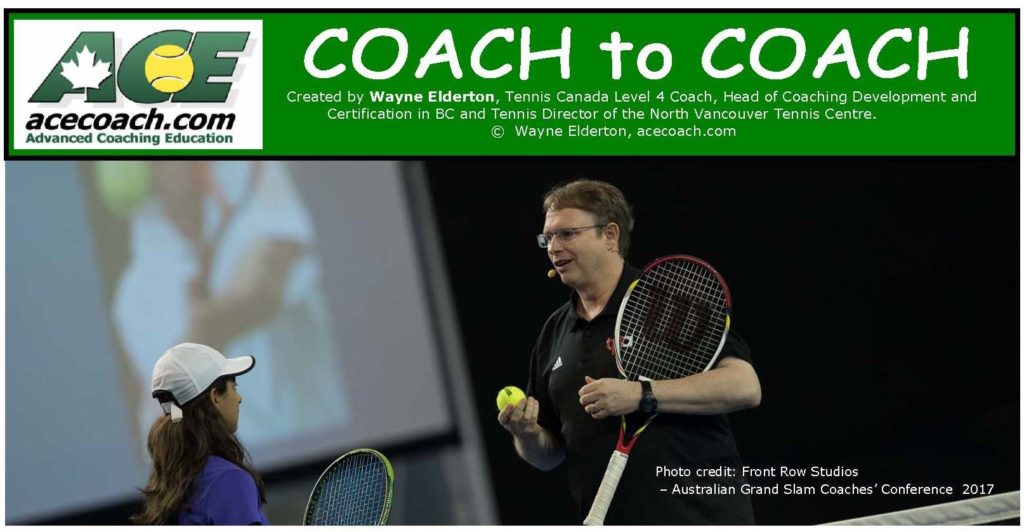
Coaching feedback is a critical tool to help people learn. By being masterful at the different aspects and applications of feedback, coaches can accelerate players learning, which makes feedback a coaching ‘power tool.’
FEEDBACK MODES: HOW PEOPLE TAKE-IN & PROCESS FEEDBACK
There are three basic ways (there are others) in which people will take in and process feedback:
VISUAL: People are wired to copy what they see. Just watch a very young child and notice how they attempt to copy other kids, siblings or adults. Visual learning is a critical piece in any motor skill acquisition.
A coach can provide visual feedback through multiple means:
- A clear visual example (e.g. a coach giving a demonstration of the shot).
- A video of the performance that can be reviewed.
- Placing targets or visual measures to show the shot’s successful achievement (E.g. A rope above the net to show the shot’s net clearance, a target on the ground to show the depth, etc.) Studies have shown placing a target on the court will increase performance by up to 300%. This is a result of the valuable feedback it provides. People are wired to accomplish a task if they see it.
AUDITORY: What people hear is also an important piece in the learning puzzle. How often have you understood you hit a poor shot by the sound it made on your strings (or frame). Verbal feedback is also an essential part of the auditory mode. Words convey powerful meaning and can enhance our understanding.
Auditory feedback can be provided in various ways:
- The coach can draw a player’s attention to sounds associated with correct performance (E.g. the sound of the shot on the strings, you know your racquet is going fast enough if you hear the ‘swish’ it makes through the air, etc.)
- The coach can use keywords that highlight the other modes (E.G. ‘This volley should feel like you are ‘catching’ the ball,’ ‘This shot should look like it ‘dips’ over the net.’, etc.)
- Words can also be used to enhance understanding important elements (E.g. ‘The ball will go where your strings are pointed.’)
KINESTHETIC: This where you feel the movements and actions you make. In motor learning, the term is proprioception. This is the body’s amazing ability to perceive its position in space. For example, if you closed your eyes and touched the tip of your nose, that is all done through the sensory neurons located in all of your muscles and joints. Coaches often underutilize kinesthetic feedback.
The ‘feel’ of a shot soon becomes the primary source of feedback for players (especially during a match). We have a saying, ‘If you can’t feel it, you can’t fix it.’ How often have you heard a player say in a post-match interview something along the lines of, ‘I couldn’t get a feel for my shots.‘?
If you can’t feel it, you can’t fix it.
To maximize the power of kinesthetic feedback and learning, I have put together a package called ‘Sensational Tennis.’ The objective of the approach is to identify key shot sensations and associate them with various feeling words. This allows players to remember how a shot should feel for effective performance. It uses the kinesthetic feels of a shot and wraps them around words that can be used as verbal feedback and associated with visual cues as well (E.g. ‘On this shot, you should feel like you are ‘blocking’ the volley. You should see your racquet is set before the impact and doesn’t move much at all.’)
(Click here for an article on Sensational Tennis: Unlocking the Power of Kinesthetic Learning)
(Click here for my YouTube video series on Sensational Tennis)

WHICH ONE SHOULD A COACH USE?
Although there are systems where only one or two of the modes are used (e.g. watching a video of your performance), by far the most robust approach is to maximize all three, all the time.
There are approaches where a coach tries to peg their players’ primary learning mode and then provides feedback through that mode. Such approaches are a myth and have been proven ineffective. The only time identifying a preferred mode is valuable is for the coach to be aware of what mode they gravitate to and ensure they do not default to their preference when coaching. Each of the modes is potent on its own, but they work in concert and enhance each other when used together.
A TRAP TO AVOID
It is crucial to avoid the trap many coaches fall into where, because they know what shots should look like (visual), and they have years of experience on what they feel like (kinesthetic), they default to verbal (auditory) feedback. They do not realize that, for them, the words capture the visual and kinesthetic elements because of their experience. They try to explain a motor action instead of providing feedback in all three modes to learn.
Coaches also think players need to have a complete intellectual understanding of an action to perform it (which isn’t true). We are making players, not coaches. Not that it is wrong or useless to understand an action intellectually, it’s just not a requirement for effective performance. The example I typically give is, we know that tennis is a complex open skill. If I throw a frisbee and you run and catch it, that is also performing an open skill. However, we can train dogs to do the same thing. How much of an intellectual understanding do they have? I am not advocating to train people like dogs but understand that all the modes are needed, and a complete intellectual understanding isn’t necessary.
CONCLUSION
Each of the three basic feedback modes (Visual, Auditory, Kinesthetic) has its own independent central nervous system, brain and muscle systems and connections. A coach can employ them all to provide feedback that accelerates learning. By using all three, they can all work together, making each one more powerful.
Leave a Reply